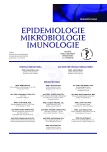Severe community-acquired pneumonia in intensive care
Authors:
H. Bartoš 1; O. Džupová 2
Authors‘ workplace:
Infekční oddělení, Masarykova nemocnice v Ústí nad Labem, 3. lékařská fakulta Univerzity Karlovy v Praze
1; Klinika infekčních nemocí, 3. lékařská fakulta Univerzity Karlovy a Nemocnice Na Bulovce, Praha
2
Published in:
Epidemiol. Mikrobiol. Imunol. 69, 2020, č. 4, s. 159-163
Category:
Original Papers
Overview
Aim: To describe the characteristics of patients with severe pneumonia treated in Czech intensive care units (ICU) and to compare this study group with the available European and world literature data.
Material and Methods: The prospective observational study launched on 1 September 2017 includes adult patients with community-acquired pneumonia from three Czech ICUs. It focuses on demographic data, chronic comorbidity, clinical and laboratory parameters, X-ray findings, microbiological findings, therapeutic procedures, and treatment outcomes.
Results: As of 31 May 2019, 74 patients, 21 females and 53 males, were included in the study. Fifty-three (71.6%) patients had an underlying chronic disease. Only one patient was vaccinated against influenza and pneumococcal infections. The main symptoms were cough and dyspnea, in 63 (85.1%) patients, pathology on auscultation, in 64 (86.5%) patients, and fever, in 23 (31.1%) patients. Bilateral pathology on X-ray was observed in 34 (45.9%) patients. The most commonly detected pathogens were Streptococcus pneumoniae, in 22 (29.7%) patients, and influenza virus, in 16 (21.6%) patients. The etiology was not established in 23 (31.1%) patients. Third-generation cephalosporins and potentiated aminopenicillin as the most common initial empirical therapies were used in 39 (52.7%) and 20 (27%) patients, respectively. The initial therapy turned out to be effective in 59 (79.7%) patients. Forty-six (62.2%) patients required mechanical ventilation, 40 (54.1%) patients required vasopressors, and 10 (13.5%) patients required the use of renal replacement therapy. The average length of ICU stay was 15.5 days. Forty-seven (63.5%) patients were discharged home, 17 (23%) patients were transferred to long-term care facilities, and 10 (13.5%) patients died.
Conclusions: The study presents the first results characterizing patients with severe community-acquired pneumonia in the Czech Republic. For most indicators, the characteristics of the Czech patients are comparable with the data from other countries, but differences were found in the pneumococcal and influenza vaccine coverage rates, which were low in the Czech Republic. Despite the appropriate empirical antibiotic therapies, severe pneumonia was associated with high mortality and prolonged morbidity.
Keywords:
community-acquired pneumonia – intensive care – Streptococcus pneumoniae – influenza
Sources
1. Woodhead M. Community-acquired pneumonia in Europe: causative pathogens and resistance patterns. Eur Respir J, 2002;20(36):20–27.
2. Torres A. Community-acquired pneumonia: Changing paradigms about mortality. Community Acquir Infect, 2014;1:1–3.
3. Morgan AJ, Glossop AJ. Severe community-acquired pneumonia. BJA Education, 2016;16(5):167–172.
4. Kolek V, Jakubec P, Losse S. Diagnostika a léčba komunitní pnuemonie – v jednoduchosti je klíč k úspěchu. Vnitř Lék, 2017;63(11):770–775.
5. Mackenzie G. The definition and classification of pneumonia. Pneumonia, 2016;8:14.
6. Johnson P, Irving L, Turnidge J. Community-acquired pneumonia. MJA, 2002;176: 341–347.
7. Rodriguez LA, Ruigomez A, Wallander MA, et al. Acid-suppressive drugs and community-acquired pneumonia. Epidemiology, 2009;20:800–806.
8. Kornum JB, Norgaard M, Dethlefsen C, et al. Obesity and risk of subsequent hospitalisation with pneumonia. Eur Respir J, 2010;36:1330–1336.
9. Ruiz M, Ewig S, Torres A, et al. Severe community-acquired pneumonia: risk factors and follow-up epidemiology. Am J Resp Crit Care Med, 1999;160:923–929.
10. Torres A, Peetermans W, Viegi G, et al. Risk factors for community-acquired pneumonia in adults in Europe: a literature review. Thorax, 2013;68:1057–1065.
11. Elshamly M, Nour M, Omar A. Clinical presentation and outcome of severe community-acquired pneumonia. Egyptian Journal of Chest Diseases and Tuberculosis, 2016;65:831–839.
12. Marrie T, Lau C, Wheeler S. Predictors of symptom resolution in patients with community-acquired pneumonia. Clinical Infectious Diseases, 2000;31:1362–1367.
13. Paganin F, Lilienthal F, Bourdin A, et al. Severe community-acquired pneumonia: assessment of microbial aetiology as mortality factor. Eur Respir J, 2004;24:779–785.
14. Brandenburg J, Marrie T, Coley C, et al. Clinical presentation, proces-ses and outcomes of care for patients with pneumococcal pneumonia. J Gen Intern Med, 2000;15:638–646.
15. Pereira R, Baptista JP, Froes F, et al. Impact of antibiotic therapy in severe community-acquired pneumonia: Data from the Infauci study. Journal of Critical Care, 2018;43:183–189.
16. Espinoza R, Silva J, Bergmann A, et al. Factors associated with mortality in severe community-acquired pneumonia: A multicenter cohort study. Journal of Critical Care, 2019;50:82–86.
17. Ferrer M, Travierso C, Cilloniz C, et al. Severe community-acquired pneumonia: characteristics and prognostic factors in ventilated and non-ventilated patients. PLoS One, 2018;13:e0191721.
18. Tessmer A, Welte T, Schmidt-Ott R, et al. Influenza vaccination is associated with reduced severity of community-acquired pneumonia. Eur Respir J, 2011;38:147–153.
19. Principi N, Esposito S. Prevention of Community-Acquired Pneumonia with Available Pneumococcal Vaccines. Int J Mol Sci, 2017;18(1):30.
20. Corcoles A, Ochoa-Gondar O, Llor C, et al. Protective effect of pneumococcal vaccine against death by pneumonia in elderly subjects. Eur Respir J, 2005;26:1086–1091.
21. Havlickova M, Druelles S, Jirincova H, et al. Circulation of influenza A and B in the Czech Republic from 2000–2001 to 2015–2016. BMC Infect Dis, 2019;19(1):160.
22. Walden AP, Clarke GM, McKechnie S, et al. Patients with community acquired pneumonia admitted to European Intensive Care Units: an epidemiological survey of the GenOSept cohort. Crit Care, 2014;18:R58.
Labels
Hygiene and epidemiology Medical virology Clinical microbiologyArticle was published in
Epidemiology, Microbiology, Immunology

2020 Issue 4
Most read in this issue
- Data from the first wave of Covid-19 from the Central Military Hospital, Prague, Czech Republic
- Severe community-acquired pneumonia in intensive care
- Individualized dosing of vancomycin in geriatric patients
- MAIT cells, their biological and medical significance
